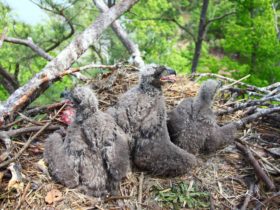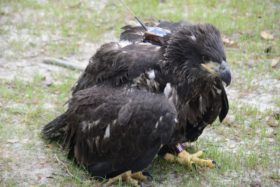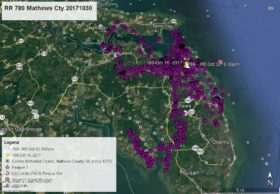For Azalea It Is Just Catfish
Camellia on West Neck Creek – VB 8/7
August 7, 2011Azalea Still at TRS Near Plymouth, NC
August 10, 2011
Since arriving back at the NC Tidewater Research Station on Aug 3, Azalea has not left the confines of the research station and the privately owned catfish ponds. She has spent a lot of time sitting right next to the fish research building (small white building to left of cluster of red hourly data points). First time I have noticed her doing that. Azalea is back to spending the night in the communal roost on TRS property in lower left of map. As of 10:00am today Aug 7, Azalea is on the edge of one of the catfish ponds – white arrow.




5 Comments
As I have on several occasions, saw an eagle this morning soaring right over Little Neck Road as was driving up the road (live on Little Neck Road) this morning, and then again about 2 hours later, soaring rather low, not real high up. Camellia? Azalea? One of the Saw Pen Point eagles? Someone else? Don’t know, but definitely an eagle. So cool to see.
Carol – Not likely AZ since she is in NC, and CAM is about 20 miles to the south. Saw Pen or Thoroughgood eagle – maybe.
Welcome back home baby girl. Glad you made it safely 🙂
Thanks Reese as always for keeping up with my Diva. She is very special to me !!!
Dix
Maybe she’s sitting next to the building eating all those catfish!!
Sorry, this is a late response. When I was at UW, there was a salmon research center and at spawning season, they would gather the salmon from the collecting pond and harvest the eggs. The fish, which naturally die after spawning anyway, were then thrown out. I don’t know if they treat catfish in any way similarly, but if so she could be sitting beside the research building waiting for takeout.
Response – Not the same situation. The catfish are being raised to go to grocery stores and resturants for us humans to eat. The catfish are harvested occasionally and taken to a fish processing plant in large tanker trucks.
Ah, thanks for the reply. So the catfish farm (mmm catfish) and the research center are near each other but not related?
Response – The NC State research station and the privately owned catfish ponds are next to each other.